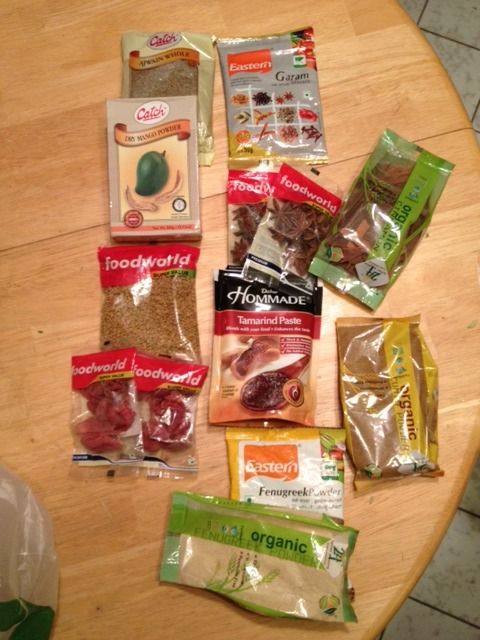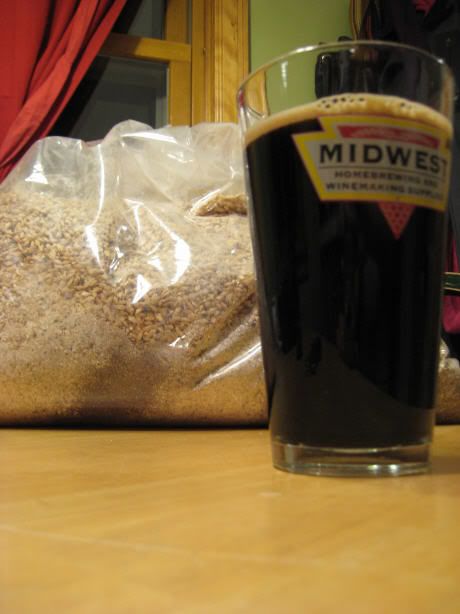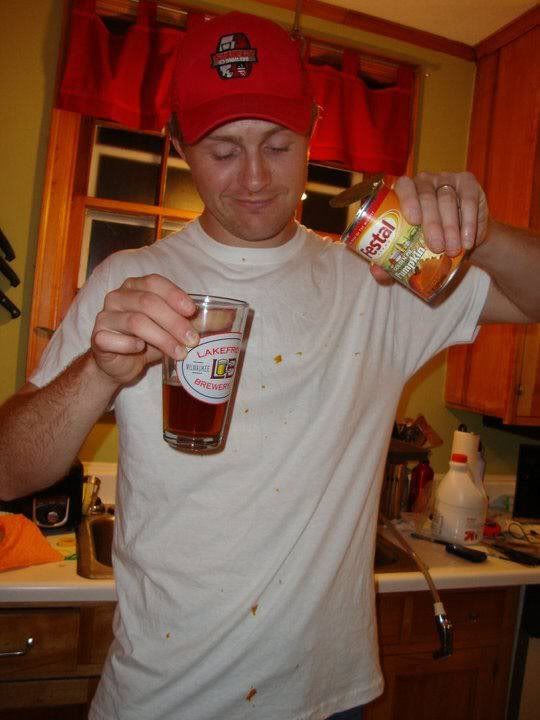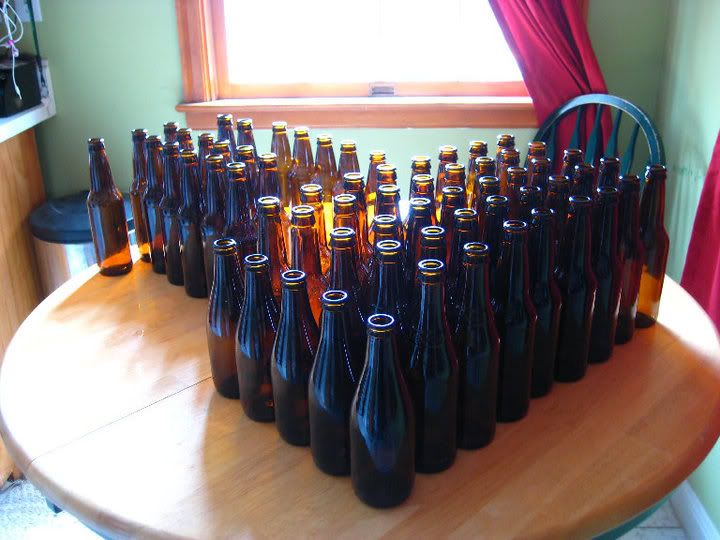Indian Pale Ale
I had some colleagues from India visit on a work trip in early September. Of course, when they asked what I would like them to bring from India, I requested spices… for brewing. This presents the perfect opportunity to make an IndiaN pale ale! How could I pass it up? I must admit, I’m not very knowledgeable regarding Indian cuisine so I had my brew club help draft a list of requests based on their culinary experience. Here is everything I received:

Since the hop harvest/brew day timing didn’t quite work out this year, I ended up drying all the hops I picked. In effect, I’m sort of combining my hop harvest pale ale into this Indian-spiced concoction of a brew day this year. However, I am still playing it safe. No spices will be added until secondary fermentation and I think I will buy smaller secondary fermenters to split the batch in half, dry-hopping both but only spicing one. This way I’ll still have some unadulterated homegrown hopped IPA and not too much spiced beer (incase it turns out over-spiced). Haven’t quite decided what spice I will add yet, but I’m leaning towards just the amchoor powder (dried mango). I’m thinking it could add a complimentary citrus/fruity note.
Here’s the base recipe (grain bill from Brewing Classic Styles, hops dictated by my homegrown supply, save for the magnum bittering addition I had lying around) and pics from the 10/7/12 brew day: (more…)
Alba Dog

I took last Friday 11/18 off work to burn through another vacation day and brew a beer. This was the first time in a while that I’ve brewed without… purpose. In July, I did two batches of pumpkin ale for Halloween/Thanksgiving, in early October I did a hop harvest beer to try out the hops I grew this past summer, and in early November I did a Belgian honey ale for release after the birth of my daughter in February. The only purpose I had in brewing this Scotch ale was that I FREAKING LOVE SCOTCH ALE. It’s probably my favorite style if I were forced to choose.
I’ve decided to call this batch Alba Dog, not in homage to Jessica Alba so much as that Alba is the Scottish Gaelic name for Scotland. Combine that with “alpha dog” and you get “Alba Dog.”
Using my nifty new iPhone and Brew Pal app., I was able to export the recipe and paste it in here: (more…)
Baby girl Belgian honey ale
 I took this past Friday off from work to brew a celebratory beer for my daughter’s impending birth (due Valentine’s Day). Doesn’t get much better than outdoor brewing on a fall Friday afternoon.
I took this past Friday off from work to brew a celebratory beer for my daughter’s impending birth (due Valentine’s Day). Doesn’t get much better than outdoor brewing on a fall Friday afternoon.
I’ve received a lot of positive feedback on the Belgian golden honey ale I brewed last February, in competition as well as from friends, so I figured I’d stick with a tasty recipe for this important batch – with one important tweak: it needed to be red for Valentine’s Day so I switched up the specialty malt bill to make it more like the red lager I brewed in 2010.
Here’s the recipe: (more…)
CUJO vs. CUJO, a dog fight!

During a recent wet hopped pale ale brew day, buddy Dave and I cracked open the very first bottle of CUJO SPICE pumpkin rye ale v2.1 as well as a bottle of v2.0 for comparison (checkout all my pumpkin ale-related posts here). Hey, if Michael Vick had been there, he might have insisted we place bets on the winner and then smash one of the bottles after it was empty. Asshole.
Each of the pumpkin rye beers I made for fall has their positives and negatives, but currently I think we decided v2.1 was slightly better than 2.0. This was also consistent with feedback received when my band taste tested 2.0 and 2.1 at practice earlier this week. (more…)
Wet Dog Pale Ale

Season 1 of my hop crop harvest culminated this past weekend with – what else – a wet hop brew day! October 1st seemed an appropriate a day as any to pick the last of my hops and dump ’em into a boiling batch of pale ale. Fortunately I had some much needed help from my buddy Dave to get all those wet hops picked while the grains were still mashing.
In addition to the roughly 10 oz. of hops I’d picked and dried (which was roughly 60 oz. wet) in the three separate harvest days prior to this, Dave and I managed to pick about 18 oz. (wet) on brew day which, if dried, would have been roughly 3 oz.
As you may have noticed, I’ve generally shied away from brewing standard or classic styles since I started nearly two years ago. I’ve sought out more adventurous recipes because 1) I can get bored of the basic styles and if I have 5 gallons of the stuff on hand, that can be a problem, and 2) it’s a lot easier to know that I messed up slightly if I I’m brewing a standard recipe, and knowing that reduces my enjoyment of the batch. BUT… I decided a basic pale ale recipe would be a great choice to show off my very own hops grown in the back yard. No complex malt profile or yeast characteristics to hide behind. The hop profile will be right up front and the batch will live or die by it. (more…)
CUJO SPICE v. 2.1 – pumpkin rye beer

V. 2.1 on the left, 2.0 on the right
The weekend after my first pumpkin spice rye beer brew day, I decided to do another batch of the stuff for the following reasons:
- My volume came up a bit lower than expected on the first brew day, maybe 4 gallons if I’m lucky
- I love pumpkin beer in the fall, so why not have more?
- Opportunity to experiment with my brewhouse efficiency – does it REALLY matter which brew shop’s mill I use?
- Opportunity to experiment with different yeast strains with the same malt bill, hops and brew day execution
Like I’d mentioned in my post covering the first pumpkin spice rye beer brew day, I’d heard from a guy in my brew club that the mill at Midwest Supplies (where I prefer to buy my grains) generally isn’t calibrated properly and thus under-mills malt, resulting in decreased efficiency. Since I’d purchased and milled my grains on version 2.0 of this recipe at Midwest, the next weekend I decided to buy and mill my grains for version 2.1 at Northern Brewer in St. Paul in order to discern whether there was any truth to the guy’s claim about attaining greater efficiency when milling at Northern. (more…)
CUJO SPICE v. 2.0 – pumpkin rye beer

Dave attacks the mash tun. Much easier to clean outside during the summer!
Wow, I haven’t clicked the “brewing” category when posting to this blog in so long… Earlier this week, I had thought about all the “work” that goes along with brewing and was a little dismayed by the thought of kicking things into gear again. That all changed when I walked into the grain room at the brew shop and was hit by aroma of malted barley. Mmmmmm. I immediately got excited to be getting back into the swing of things.
Here’s the recipe for my 2011 Halloween brew:
Base: 7.75 lbs. American 2-Row (Rahr), 3.5 lbs. Rye malt (Weyermann), 1.75 lbs. light Munich malt (Weyermann)
Specialty: .29 lbs. Crystal malt 50-60L (Simpson’s), .28 lbs. flaked wheat
Hops: 1.0 oz. Mt. Hood pellets (60″), 1.0 oz. Argentine Cascade pellets (2″)
Yeast: White Labs WLP001 California Ale Yeast (1600 ml yeast starter, 1 c light DME)
Irish moss (15″), yeast nutrient (10″), 1 tsp. nutmeg and 1 tsp. cinnamon (2″)
Unlike last year, this year’s CUJO SPICE recipe is a rye beer with a small addition of pumpkin spice rather than a straight up pumpkin ale. I thought about including actual pumpkin like last year, but worried that in conjunction with the rye would produce a beer so cloudy it would never achieve clarity. I don’t think the actual pumpkin adds a lot of flavor to a pumpkin beer anyway. It’s mostly the spices you end up tasting. I used a bit less spice this year to give the rye flavor the opportunity to mix and meld harmoniously with the pumpkin spices. We’ll see how it turns out. (more…)
In the name of doG
Had a nice little brew session this past Presidents’ Day. Great use of a day off work especially because Minneapolis got hit with a big snow storm (13 inches) the day before. Fortunately I’d purchased all my supplies to get my yeast starter going the day before the storm.

Boil additions, in order
Holed-up in the house and brewing on my day off? Sounds good to me. I did a Belgian honey ale, calling it “In the Name of doG” as a play on the common religious phrase and the fact that many strong Belgian beers like this one are often brewed by monks.
After discussing sparging methods with another brewer at the recent Nordeast Homebrewers Alliance meeting I attended, I decided to move things along a bit quicker during this brew day, so I only fly-sparged for about an hour as opposed to 2+ hr. sparges I’d done on previous all-grain brew days. I also researched a little during the boil on how to calculate efficiency in sugar extraction, and… bah, that’s too complicated for me to care about yet.
Here’s the recipe:
Base: 7lbs Rahr domestic 2 row, 4 lbs. wheat malt
Specialty: 8 oz. Cara II (was supposed to be Caravienne but Midwest was out of that malt), 8 oz. Carapils
Hops: 1 oz. Liberty (60″), 1 oz. Liberty (50″), 1 oz. Styrian Goldings (2″)
Adjuncts: 1 lb. Clover honey (25″), 2 or 3 cups light DME (20″), 1 lb. Clover honey (10″), 1-2 tsp Wyeast yeast nutrient (8″), 1 lb. Belgian Candi sugar (8″), .5 oz bitter orange (5″), .5 oz. coriander (5″), 1-2 tsp Wyeast yeast nutrient (8″)
Yeast: White Labs Belgian Ale WLP550 (2000 ml yeast starter with 1 cup light DME at 1.038, 36 hrs. prior to pitch)
Bottling the Scottie and Mutt Lite
I got the batch of Scootin’ Scottie Ale and the Mutt batch bottled back on Saturday 2/12. Finally getting around to posting some pics below.

I taste tested and took the gravity of each batch. The Scottie finished within target, at about 7.1 brix or 1.012. This means that since the Scottie’s specific gravity started at 1.057, the ABV comes to just about 6.1%. I’d been taste-testing it along the way as it fermented down, and it really finished off crisp but full-bodied compared to where it started. I’m very, very pleased, even just tasting it before it was carbonated. I might like this batch more than my Off-leash Coffee Stout (which got some great verbal feedback at a recent homebrew club meeting recently, by the way — more on that in a future post).
After tasting the Mutt, I’ve decided to re-christen it “Mutt Lite.” Man, did it ever taste like warm Bud Lite! Yuck!! I mean, maybe friends who don’t like good beer will like it. It started at 1.032 and finished at 1.005, making it 3.5% ABV.
Finally, at the very bottom you’ll find some pics of my ever-growing beer cellar.
Cheers! (more…)
Cold-crashing the Scottie
Fermentation finally cooled off on the Scottie this past weekend. It had been almost three solid weeks since brew day. I guess this is just a characteristic of the Edinburgh Scottish yeast strain? Anyone else out there experience long fermentations with this yeast? Is it because they recommend fermenting with this yeast at 60-65* (as I did)? Somebody clue me in please.
day. I guess this is just a characteristic of the Edinburgh Scottish yeast strain? Anyone else out there experience long fermentations with this yeast? Is it because they recommend fermenting with this yeast at 60-65* (as I did)? Somebody clue me in please.
I took a hydrometer reading Saturday and it came in at 7.25-7.5 brix, which equates to 1.012-1.014 FG, the target FG for this recipe. Once I transferred to secondary, I decided to experiment with the practice of “cold-crashing.” Cold-crashing is where you bring the recently fermented beer down to near-freezing temperatures in the secondary fermenter in order to cause a greater amount of yeast cells to shutdown and drop out of solution. The more yeast you can get to flocculate and drop to the bottom of the fermenter, the clearer your finished-product will be.
Though “clear” isn’t necessarily a defining characteristic of a dark beer, it should be clear to the extent you could see through it when you hold it up to the light. What I mean by this is that dark beer shouldn’t necessarily be hazy. A lack of haze is what I’m going for here. (more…)
Mutt and the parti gyle
As I was reaching my initial wort volume in the boil kettle last weekend for the SaiSon of a Bitch batch, I realized there was a substantial amount of liquid left in the mash tun (which I now sort of regret not bringing into the main kettle, as I came up short volume-wise after the main boil, but with an OG of 1.068 or something high like that). Since I thought I had maybe 7 gal. in the main kettle, I decided to do a parti gyle and get a second batch out of this brew day. A party gyle is an old English brewing practice where, after the wort volume for a strong beer was collected, additional water was circulated through the grain bed to obtain a weaker version of the wort for the production of what could be described as a “table beer” or a beer for local peasants. Here’s a more detailed analysis of the practice.
there was a substantial amount of liquid left in the mash tun (which I now sort of regret not bringing into the main kettle, as I came up short volume-wise after the main boil, but with an OG of 1.068 or something high like that). Since I thought I had maybe 7 gal. in the main kettle, I decided to do a parti gyle and get a second batch out of this brew day. A party gyle is an old English brewing practice where, after the wort volume for a strong beer was collected, additional water was circulated through the grain bed to obtain a weaker version of the wort for the production of what could be described as a “table beer” or a beer for local peasants. Here’s a more detailed analysis of the practice.
Since the opportunity was presenting itself to make another batch (and since I had open fermenters I could use) I went for it. I’m going to call this brew “Mutt” because it’s just a mix of some random stuff and kind of an experiment. Here’s what I ended up doing:
Base, Specialty: Last runnings from SaiSon of a Bitch’s grist plus 1.5 C Pilzen DME I had on hand for making yeast starters
Extras: 1 C Brown Sugar for good luck
Hops: 1/2 oz. Challenger hops (7%) unused from the Scootin’ Scottie brew day last month
Yeast: Fermentis SafAle S-04 dry yeast that came free with some previous batch
My pre-boil OG = 1.032
My post-boil OG = 1.022 (5.5 Brix) (more…)
Scootin' Scottie Ale update
I checked the gravity of my Scootin’ Scottie Ale (Scottish 80 /- Export) this past weekend. After two straight weeks, fermentation had finally calmed down. The airlock was bubbling once every 7 to 9 seconds (the airlock had been bubbling once every 4 to 5 seconds for the first 10 days), so I figured it might be time to transfer the batch to secondary. I took a refractometer reading this past Sunday 1/30 that came in at about 9 brix or a little over what I’m shooting for. That equates to a gravity reading of roughly 1.024 – 1.020, where I’m actually looking for 1.014 to 1.012 for this style.
fermentation had finally calmed down. The airlock was bubbling once every 7 to 9 seconds (the airlock had been bubbling once every 4 to 5 seconds for the first 10 days), so I figured it might be time to transfer the batch to secondary. I took a refractometer reading this past Sunday 1/30 that came in at about 9 brix or a little over what I’m shooting for. That equates to a gravity reading of roughly 1.024 – 1.020, where I’m actually looking for 1.014 to 1.012 for this style.
On Tuesday night 2/1, I snagged another sample out of the carboy and the brix reading came in at 8.0-8.5, which is 1.017-1.020. It’s arguably moved down a bit, but the airlock is bubbling once every 9-11 seconds now, so I’m concerned fermentation is stalling right near the end. The fact that it just got a bit colder outside again (and colder in the house) didn’t help either, as the batch got down to about 58*, a few too low for this yeast strain. (more…)
Scootin' Scottie Ale
Have you ever seen a Scottie dog scoot? Pretty funny… or gross, depending on if you’re the owner of the carpet. Anyway, while looking around at options for my next batch of beer, I had originally intended to do a sweeter style brown ale, as I’d had a few really good exemplars of the style over the holidays. I got distracted by a slightly different style though after reading around a bit. I’m not a HUGE fan of lagers (I find ales more flavorful, generally) and I already have one lager “lagering,” but I also would like to still try and take advantage of the ambient temps I can find in my Minnesota home in the dead of winter. Solution? A Scottish 80/- Export (the 80/- means 80 shillings, which is how much a beer of this style and alcoholic strength was taxed when it was popular a few hundred years ago — 80 shillings). This strength of Scottish Ale was often the strength sold to other countries, hence “export” in the name.
as I’d had a few really good exemplars of the style over the holidays. I got distracted by a slightly different style though after reading around a bit. I’m not a HUGE fan of lagers (I find ales more flavorful, generally) and I already have one lager “lagering,” but I also would like to still try and take advantage of the ambient temps I can find in my Minnesota home in the dead of winter. Solution? A Scottish 80/- Export (the 80/- means 80 shillings, which is how much a beer of this style and alcoholic strength was taxed when it was popular a few hundred years ago — 80 shillings). This strength of Scottish Ale was often the strength sold to other countries, hence “export” in the name.
The yeast used by this style of ale is a perfect match to the ambient temps in my house right now. Primary needs 60-65*, which I can easily find in my basement, and secondary needs 35-45* which I can easily find in the closet next to my garage.
I knew I liked this type of beer because I bought a six pack of Odell’s 90 Shilling last summer and the taste has stuck in my mind ever since. Big fan of how smooth and flavorful it was. A nice alternative to IPA’s in my opinion. Completely different… but so completely different that it’s as interesting (even for a fan of IPAs) to try.
Base malt: 11 lbs domestic 2-row
Specialty: 4 oz Biscuit, 8 oz Caramel 40L, 8 oz Chocolate Malt, 2 oz Special B, 1 oz Peat malt (pre-mixed)
Hops: 1/2 oz Challenger, 1 oz. Fuggles (U.S.)
Yeast: White Labs Edinburgh Ale Yeast WLP028
CUJO SPICE Pumpkin Ale
Friends Jim and MaKenzie came over to help me brew this batch on a Friday night, and honestly we got a little drunk on some good craft brews (apparently the delicious Alfrenzo pizza from Fat Lorenzo’s didn’t offer enough sustenance) so the details are as hazy as this beer turned out. Also, some friends in town stopped by as we were in the process of transferring this beer into the primary fermentor and I got a bit distracted. I almost started to boil the priming sugar for bottling! Whoops. Did I mention already we weren’t sober for this brew day?
drunk on some good craft brews (apparently the delicious Alfrenzo pizza from Fat Lorenzo’s didn’t offer enough sustenance) so the details are as hazy as this beer turned out. Also, some friends in town stopped by as we were in the process of transferring this beer into the primary fermentor and I got a bit distracted. I almost started to boil the priming sugar for bottling! Whoops. Did I mention already we weren’t sober for this brew day?
What I can tell you: (more…)
Double Dog Dare IPA
This is the first brew day I attempted solo. Like I’ve said, I love IPA’s so why not try and make a double IPA. I was still doing extract boiling at this point so this recipe consisted of pretty much double the extract syrup of the Snaggletooth IPA recipe along with a shit ton of hops added at various points of the boil. Part of the extract partial boil recipe has you make “hop tea” where you… make a tea with hop pellets. Kinda fun. I love the smell of hops. I started understanding the hydrometer a bit more at this point so I actually took and kept some readings recorded:

OG: 1.086 (recipe had me shooting for 1.083)
FG: 1.021 (the end result seemed a bit sweet and I think this was why)
I recall transferring this to secondary and dry-hopping on June 26th or 27th I believe. The hop pellets moved around quite a bit, which seemed good. I seem to recall having a busy summer and not getting around to bottling this batch until early August, which was maybe a mistake? August 27th was the big day, the first bottles to be cracked at my buddy Jim’s new house for a BBQ. NO CARBONATION! It tasted pretty good but no bubbles at ALL. So pissed. I worked pretty hard on this batch so I was mad.
Snaggletooth IPA
Dad brewed with me again. We used all spring water this time, not distilled as with the first batch. It turned out GREAT! This batch was given the name Snaggletooth IPA after Leiny’s snaggletooth.
GREAT! This batch was given the name Snaggletooth IPA after Leiny’s snaggletooth.
I’m a big fan of India Pale Ale’s, so I thought I’d try my hand at one. IPA’s have such a distinctive hop character they just smack you in the face. This probably plays well into my personality, as I’m an all-or-nothing kind of guy, most of the time. The recipe I used was Northern Brewer’s Chinook IPA extract kit. Partial boil. I believe chinook hops were used for both bittering and aroma in this recipe. (more…)

 Back on 10/23 (16 days after brew day), I took Snot Snout, my imperial chocolate stout, and transferred it to another primary fermenter. Awaiting in that second vessel were six full pounds of pasteurized, pitted and thawed cherries. Just like with my
Back on 10/23 (16 days after brew day), I took Snot Snout, my imperial chocolate stout, and transferred it to another primary fermenter. Awaiting in that second vessel were six full pounds of pasteurized, pitted and thawed cherries. Just like with my 
 yeast you’ve purchased so they can begin to eat the sugars in the mini-batch of beer and reproduce. When you finally pitch this mini-batch of beer with all the additional yeast cells into the actual batch of beer you’re brewing, fermentation will begin much sooner and with much more vigor than it otherwise would if you’d just pitched the yeast you purchased directly into your batch of beer. There are many advantages to a vigorous and timely fermentation.
yeast you’ve purchased so they can begin to eat the sugars in the mini-batch of beer and reproduce. When you finally pitch this mini-batch of beer with all the additional yeast cells into the actual batch of beer you’re brewing, fermentation will begin much sooner and with much more vigor than it otherwise would if you’d just pitched the yeast you purchased directly into your batch of beer. There are many advantages to a vigorous and timely fermentation.